Matcha may support energy, focus, metabolism, and overall wellness due to its rich antioxidant and nutrient profile. This vibrant green tea powder, made from finely ground Camellia sinensis leaves, offers a unique nutritional advantage over regular green tea — you consume the entire leaf, maximizing the benefits of catechins, L-theanine, and other bioactive compounds.
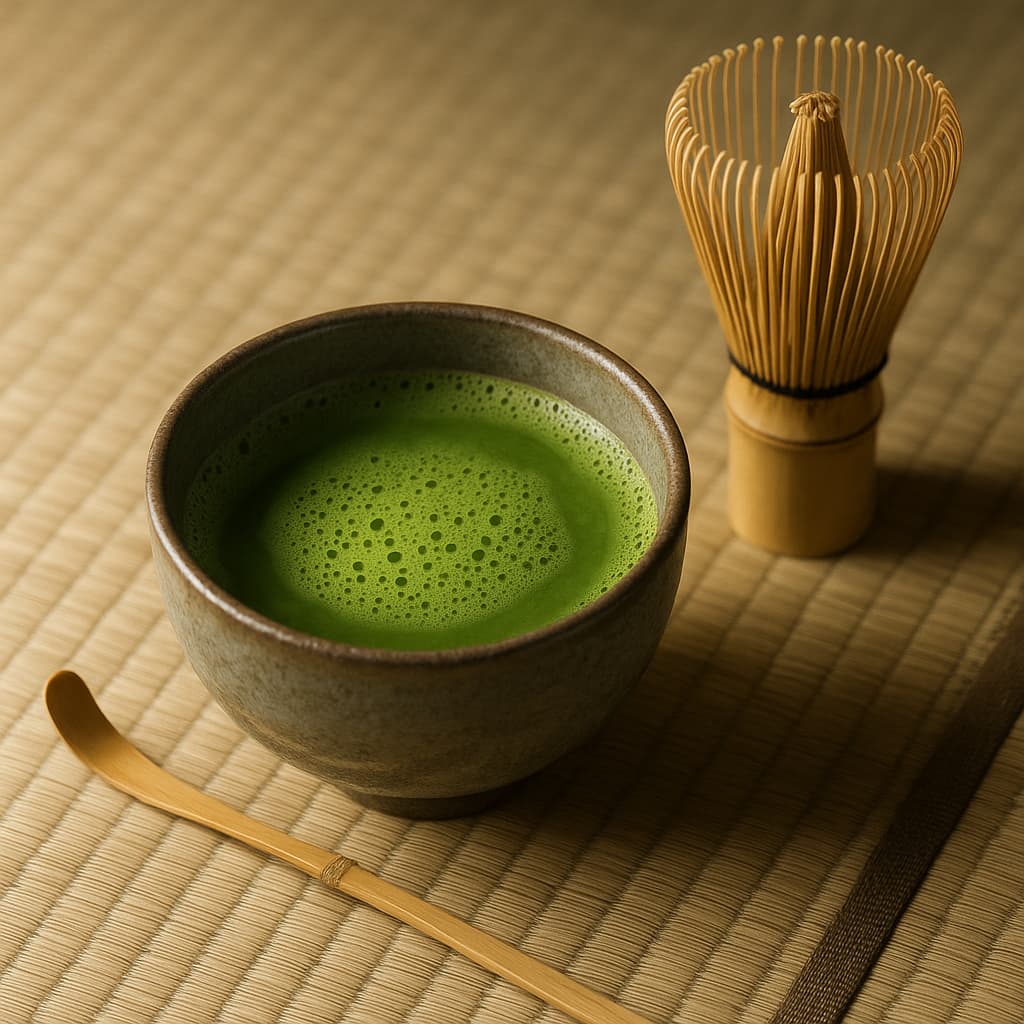
Understanding the science behind matcha helps you make informed, health-conscious choices for your daily routine. Below, we explore research-based benefits, nutritional facts, safe usage, and important precautions.
What Is Matcha?
Matcha is a finely ground, bright green powder made from specially grown Camellia sinensis leaves — the same plant used to make green, black, and oolong teas. Unlike traditional tea, where leaves are steeped and discarded, matcha is whisked directly into water or milk, allowing you to consume the entire leaf and all its nutrients.
Origin and Traditional Use
Matcha has deep roots in Japanese culture, originating from Zen Buddhist practices nearly 800 years ago. Monks valued it for sustaining alertness and meditation due to its unique balance of caffeine and L-theanine. Today, matcha remains central to Japanese tea ceremonies (chanoyu) and has gained global popularity for its vibrant flavor and wellness benefits.
How Matcha Differs from Regular Green Tea
- Cultivation: Matcha plants are shade-grown for 3–4 weeks before harvest, increasing chlorophyll and amino acid levels.
- Processing: After harvesting, leaves are steamed, dried, and stone-ground into a fine powder, preserving antioxidants.
- Consumption: Because you drink the entire leaf, matcha provides a more concentrated source of nutrients and antioxidants than steeped teas.
Nutritional and Functional Advantage
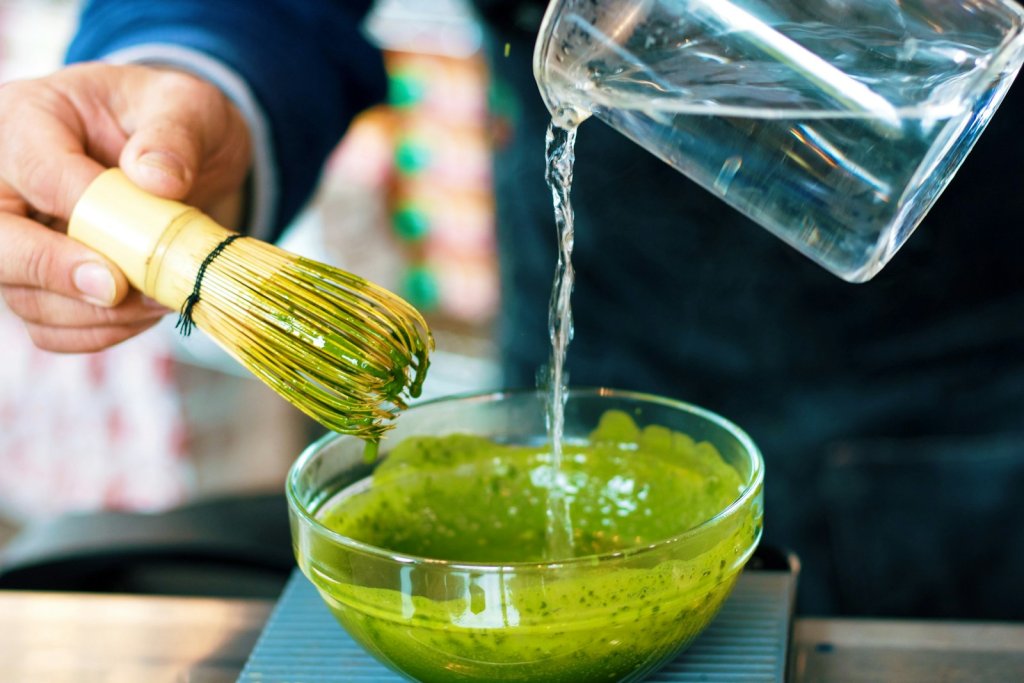
Consuming the whole powdered leaf means you get higher concentrations of catechins (EGCG), L-theanine, chlorophyll, and micronutrients. These compounds may support antioxidant defense, calm focus, metabolism, and overall wellness.
According to Harvard Health Publishing (2024), matcha’s nutritional edge lies in its potent polyphenols and amino acids, which together promote balanced energy and cognitive clarity. The Molecules journal review (2022) confirms matcha delivers significantly higher antioxidant activity than conventional green tea due to its unique preparation and composition (Molecules, 2022).
In summary: Matcha is not just a type of green tea — it’s a nutrient-dense, shade-grown powerhouse that supports energy, focus, and antioxidant protection when consumed in moderation.
Nutritional Profile of Matcha
The concentrated nature of matcha provides a potent mix of antioxidants, amino acids, vitamins, and minerals. Even a small serving (1–2 grams) delivers meaningful nutritional and functional benefits.
Average Nutritional Composition (Per 2 g / 1 Teaspoon)
| Nutrient | Amount | Function / Benefit |
|---|---|---|
| Calories | ~5 kcal | Minimal energy contribution |
| Protein | 0.3 g | Cellular structure support |
| Caffeine | 60–70 mg | Sustained alertness and focus |
| L-Theanine | ~20 mg | Promotes relaxation and concentration |
| Catechins (EGCG) | ~70 mg | Supports antioxidant and metabolic health |
| Total Polyphenols | 240–300 mg | Helps reduce oxidative stress |
| Chlorophyll | High | Supports detoxification and cell vitality |
| Vitamin C | 1–2 mg | Contributes to immune defense |
| Vitamin A (as β-carotene) | Trace | Supports eye and skin health |
| Potassium | ~27 mg | Maintains electrolyte and fluid balance |
| Iron, Zinc, Manganese | Trace | Support enzyme and antioxidant function |
(Data: USDA FoodData Central & Molecules Journal, 2022)
10 Proven Health Benefits of Matcha (Backed by Science)
1. Supports Antioxidant Protection
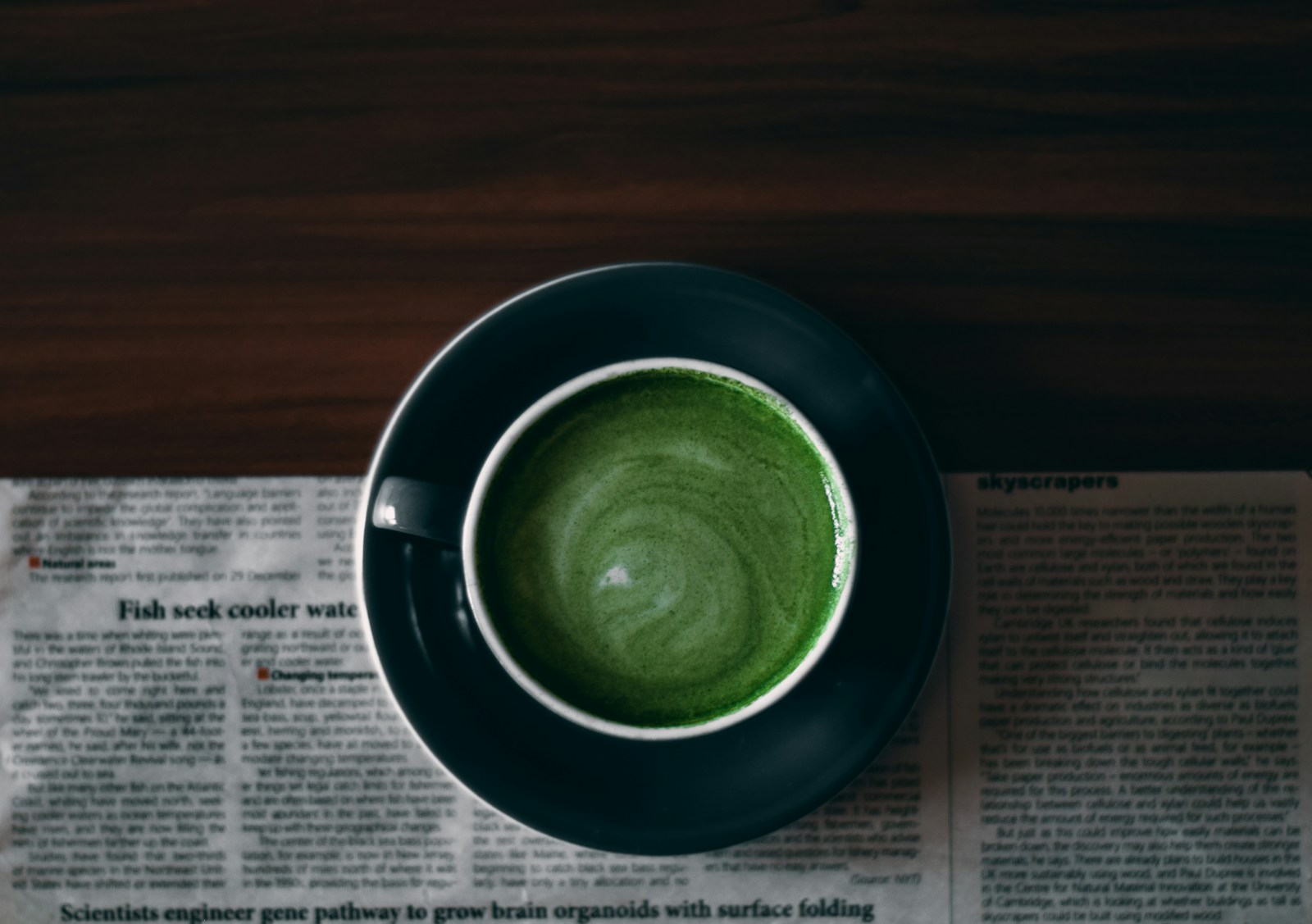
Matcha is exceptionally rich in catechins, especially epigallocatechin gallate (EGCG) — a potent antioxidant that may help neutralize harmful free radicals. Because matcha is made from whole, ground tea leaves, it delivers a much higher concentration of antioxidants than regular steeped green tea.
A review published in the Molecules journal (2022) found that matcha contains up to 137 times more EGCG than conventional green tea, highlighting its powerful antioxidant capacity (Molecules Journal, 2022). These antioxidants help reduce oxidative stress, which supports overall cellular health and may protect against environmental and metabolic damage.
In summary: Regular matcha consumption may help strengthen the body’s natural defense system against oxidative damage, supporting long-term wellness when part of a balanced diet.
2. Promotes Calm Focus and Mental Clarity
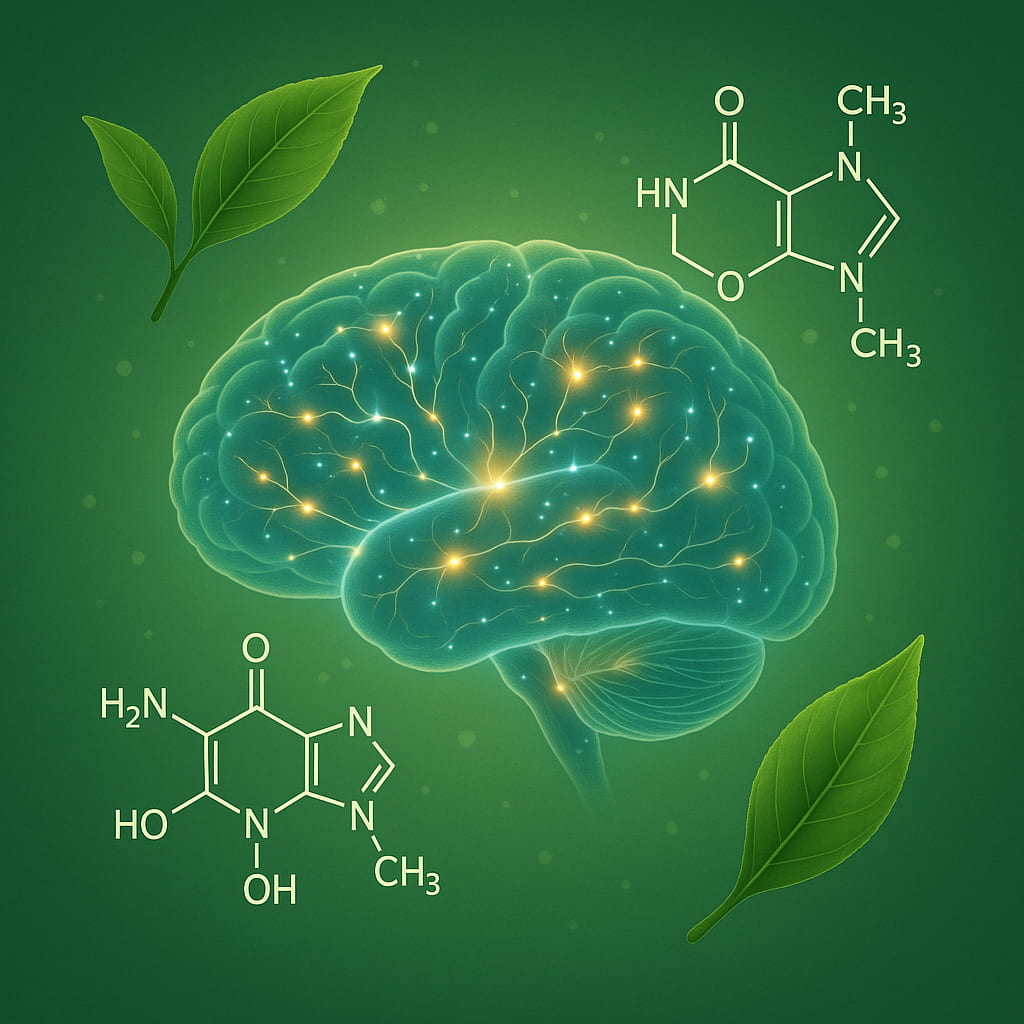
Matcha naturally contains both caffeine and L-theanine, an amino acid known for promoting calm alertness. Unlike coffee, matcha’s caffeine is released slowly, providing sustained energy without spikes or crashes.
A study published in the Journal of Functional Foods (2020) found that participants who consumed matcha experienced improved attention, reaction time, and memory compared to placebo. This cognitive effect is linked to the synergistic relationship between caffeine and L-theanine, which promotes mental clarity while minimizing anxiety or overstimulation.
In summary: Matcha may support sustained focus, learning capacity, and relaxation—making it ideal for study sessions, work, or mindfulness practices.
3. May Help Support Heart Health

The catechins in matcha may play a role in supporting cardiovascular health. Research summarized in the journal Nutrients (2021) found that regular green tea consumption was associated with lower LDL (“bad”) cholesterol, improved endothelial function, and reduced oxidative stress in blood vessels.
Additionally, observational studies show that people who drink green tea regularly have a lower risk of cardiovascular events, though direct evidence for matcha specifically is still developing (Harvard Health Publishing, 2024).
In summary: Drinking matcha as part of a heart-healthy diet may support blood lipid balance and vascular function, complementing regular exercise and balanced nutrition.
4. Aids Metabolic and Weight Management
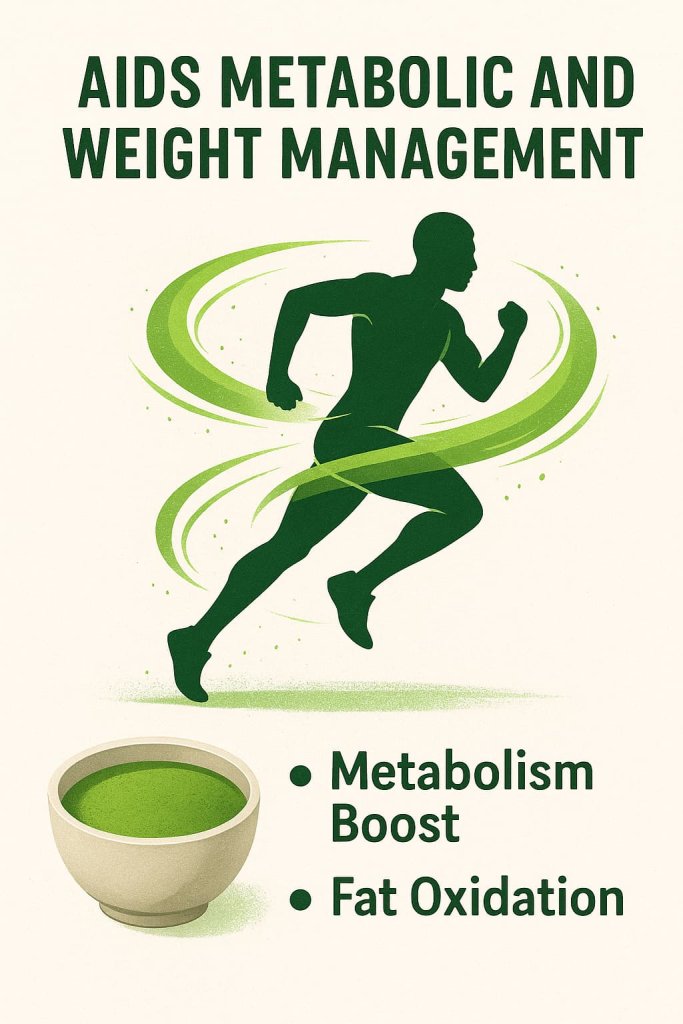
Matcha may help support a healthy metabolism due to its combination of caffeine and EGCG. These compounds work synergistically to promote fat oxidation and energy expenditure.
A controlled study published in the American Journal of Clinical Nutrition (2018) reported that individuals who consumed green tea catechins burned more fat during moderate exercise compared to those who didn’t. Additionally, matcha may help balance blood sugar levels and reduce post-meal spikes, supporting healthy weight management.
In summary: While matcha alone isn’t a weight-loss solution, incorporating it into a balanced diet and active lifestyle may enhance metabolic efficiency and support healthy body composition.
5. Supports Liver Function
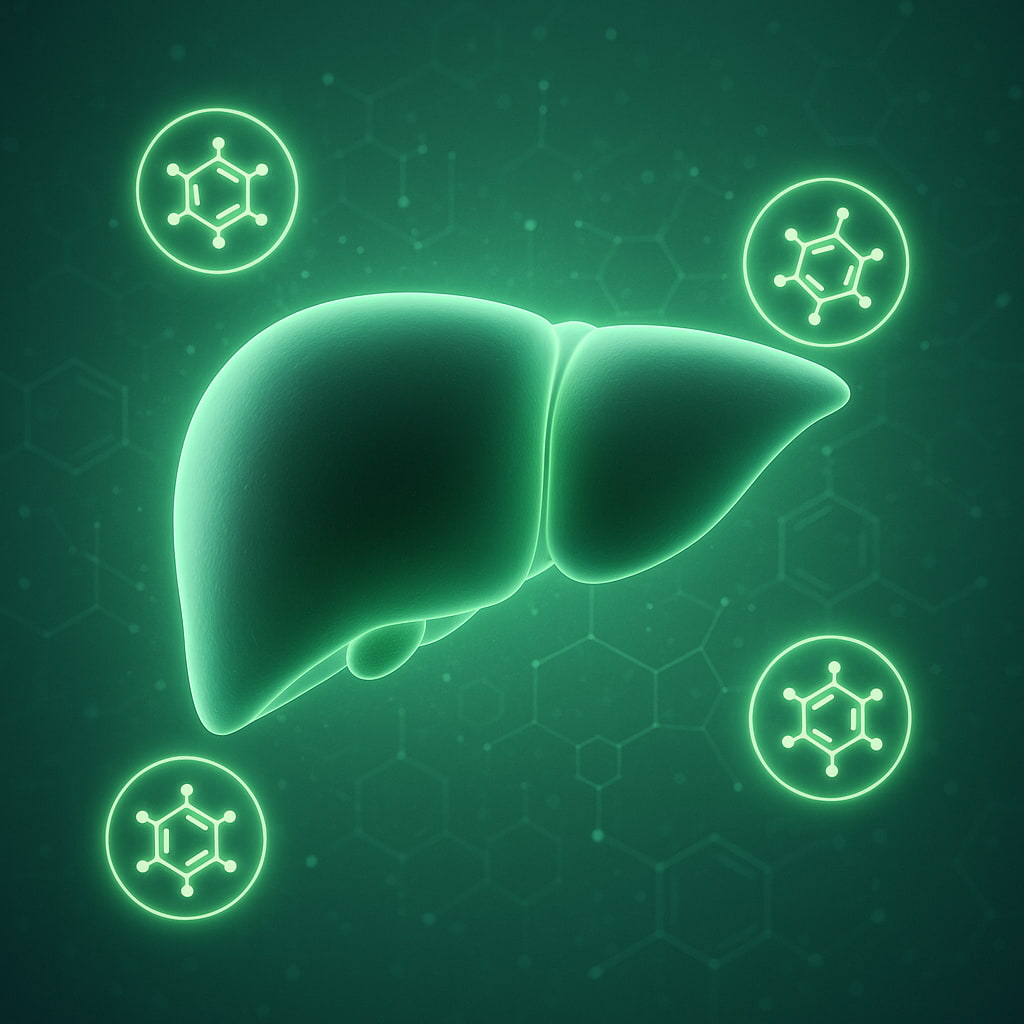
Animal and small human studies suggest that the EGCG and polyphenols in matcha may help protect liver cells from oxidative stress. These compounds have been linked to improved enzyme balance and reduced markers of liver inflammation in some trials.
However, Harvard Health Publishing (2024) advises moderation, as high doses of concentrated green tea extracts (not food-grade matcha) have been associated with liver stress in rare cases. Regular culinary matcha use, however, remains safe for most individuals (Harvard Health Publishing, 2024).
In summary: Consuming moderate amounts of matcha may support liver function and antioxidant balance but should not replace professional medical treatment or screening.
6. Enhances Immune Support
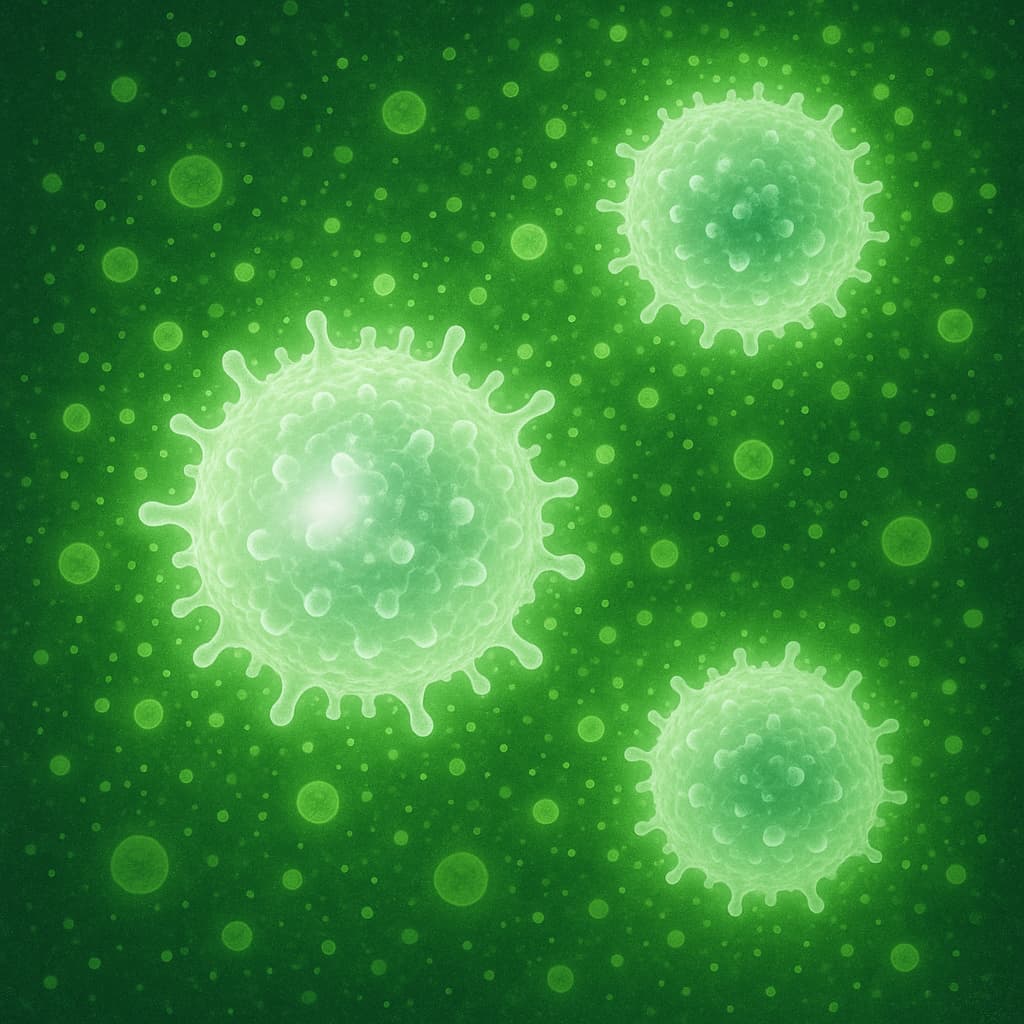
Matcha is rich in polyphenols, chlorophyll, and small amounts of vitamin C — all of which support the body’s immune defense. The catechins in matcha exhibit mild antimicrobial and anti-inflammatory properties, which may help maintain immune resilience.
Studies published in Frontiers in Nutrition (2023) have shown that green tea catechins may modulate immune cell activity and reduce markers of oxidative stress. This immune-balancing effect contributes to overall wellness during periods of stress or seasonal change.
In summary: Including matcha in your diet may provide antioxidant and immune support, especially when paired with other nutrient-dense foods such as fruits, vegetables, and whole grains.
7. May Support Gut and Digestive Health
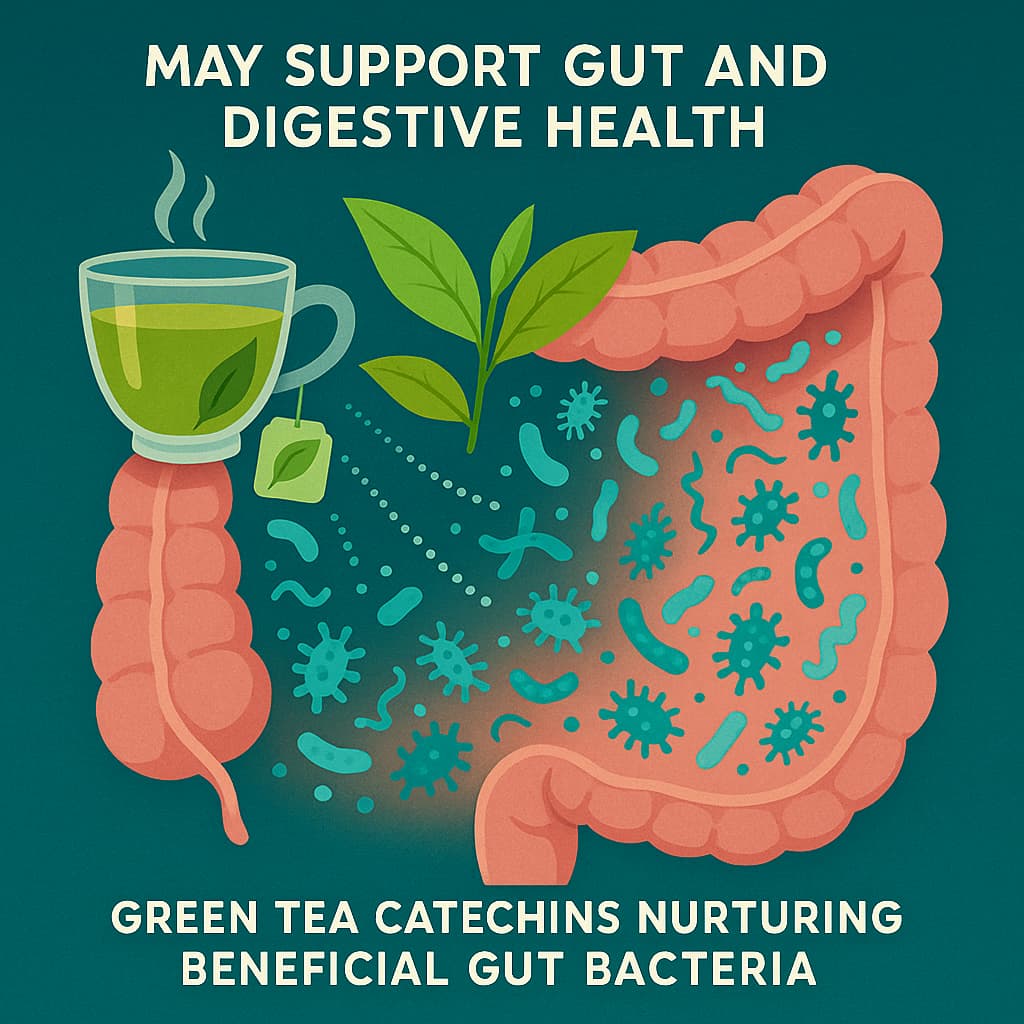
Emerging evidence suggests that the polyphenols and fiber in matcha may encourage beneficial gut bacteria growth. A 2023 study published in Frontiers in Nutrition found that regular green tea intake promoted a healthier gut microbiome and reduced inflammation-related biomarkers.
These compounds act as prebiotics, helping to nourish beneficial bacteria like Lactobacillus and Bifidobacterium, which play key roles in digestion, immunity, and mood regulation.
In summary: Matcha may support a balanced gut microbiome and digestive comfort when combined with a fiber-rich diet and adequate hydration.
8. Promotes Skin Health

The antioxidants in matcha — especially EGCG — may help protect the skin from UV-related oxidative damage and inflammation. Topical and dietary intake of green tea polyphenols have been shown to support skin elasticity, barrier function, and hydration.
A 2020 review in Nutrients highlighted that EGCG may reduce redness, oxidative stress, and photoaging when combined with a balanced skincare routine. While human data on matcha specifically are limited, its antioxidant properties make it a valuable addition to a skin-supportive diet.
In summary: Drinking matcha may contribute to overall skin wellness and radiance by reducing oxidative stress and supporting collagen balance.
9. Supports Energy and Endurance

With about 60–70 mg of caffeine per 2 g, matcha provides a gentle yet sustained energy boost. The presence of L-theanine smooths caffeine’s effects, offering steady focus and reduced fatigue.
Research in Nutrition Journal (2023) found that green tea supplementation improved exercise performance, endurance, and post-exercise recovery in healthy adults. Because matcha is a concentrated form of green tea, similar benefits are likely applicable.
In summary: Matcha is a clean energy source that supports endurance, mental clarity, and recovery, making it an ideal pre-workout or morning beverage.
10. May Support Cognitive Aging

Long-term consumption of matcha may support cognitive and emotional well-being as part of a balanced lifestyle. A 2024 study published in Psychopharmacology reported that older adults who consumed 2 g of matcha daily experienced improved sleep quality, mood balance, and emotional regulation.
The study noted modest improvements in cognitive performance, likely related to matcha’s unique combination of caffeine, L-theanine, and antioxidants. These compounds may protect brain cells from oxidative damage and promote neurotransmitter balance.
How to Use Matcha for Best Results
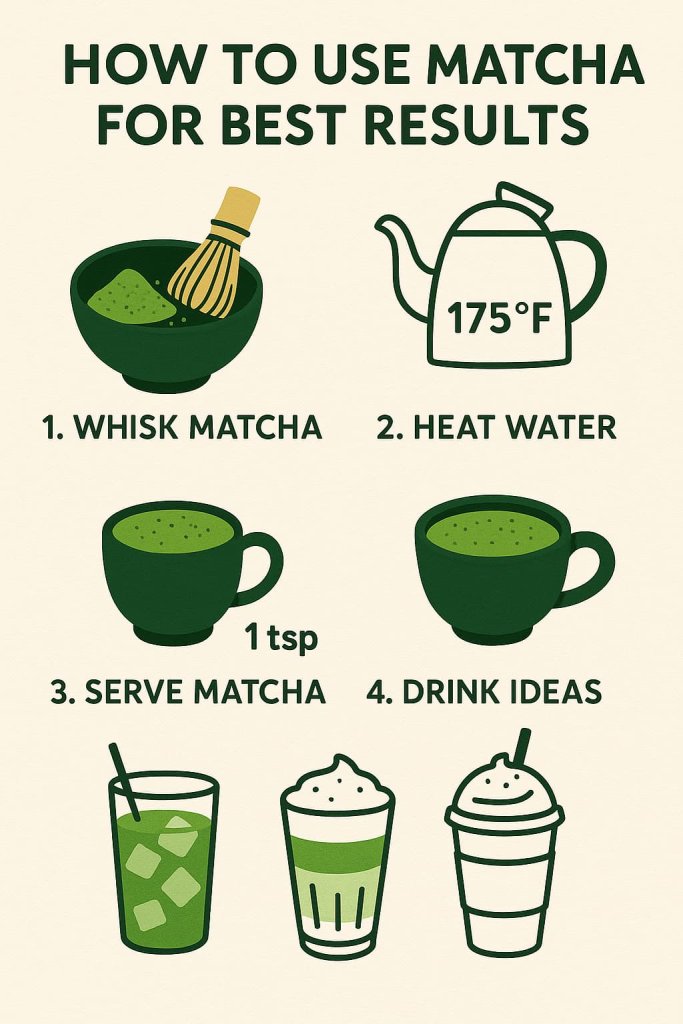
To fully experience matcha’s health and wellness benefits, preparation and serving methods matter. Because matcha is concentrated, small daily servings are enough to support energy, focus, and antioxidant intake safely.
Preparation Guidelines
- Serving size: 1–2 teaspoons (2–4 g) of culinary or ceremonial-grade matcha per day is ideal for most adults.
- Water temperature: Use water no hotter than 175 °F (80 °C). Boiling water can degrade delicate catechins and L-theanine.
- Whisking method: Sift the powder to remove clumps, then whisk briskly in a “W” motion using a bamboo whisk (chasen) until frothy.
Best Times to Drink Matcha
- Morning: For calm focus and gentle energy.
- Pre-workout: Caffeine and catechins may support endurance and metabolism.
- Midday: To sustain attention and reduce afternoon fatigue.
Healthy Pairings and Combinations
- Smoothies & Lattes: Combine matcha with almond milk, oat milk, or coconut milk for a creamy antioxidant beverage.
- Food Pairings: Matcha blends well with fiber- and protein-rich foods (e.g., oats, yogurt, chia seeds).
- Iron absorption tip: Avoid drinking matcha with iron-rich meals; catechins may reduce non-heme iron absorption.
In summary: Use matcha daily in moderate amounts, whisk gently at a safe temperature, and pair it with nutrient-dense foods for optimal absorption and sustained wellness benefits.
Possible Side Effects and Precautions
While matcha is generally safe for most people, it’s important to understand its potential side effects and use it responsibly. Because matcha is a concentrated form of green tea, moderation is key to maintaining balance between its health benefits and possible sensitivities.
Caffeine Sensitivity
Each 2-gram (about 1 teaspoon) serving of matcha provides roughly 60–70 mg of caffeine, which is similar to a small cup of coffee. According to the National Center for Biotechnology Information (NIH, 2024), individuals vary in how they metabolize caffeine, and excessive intake can cause symptoms such as nervousness, rapid heartbeat, or insomnia (NIH – Caffeine Overview).
If you are sensitive to caffeine, limit your intake to no more than 2 teaspoons per day and avoid drinking matcha late in the evening.
Iron Absorption
Catechins, the antioxidants that make matcha so beneficial, can also inhibit non-heme iron absorption from plant-based foods. For this reason, nutrition experts recommend consuming matcha between meals, not alongside iron-rich foods or supplements, especially for vegetarians or those prone to low iron levels.
Liver Health
While moderate matcha consumption is considered safe, high-dose green tea extract supplements have occasionally been linked to liver stress. According to Harvard Health Publishing (2024), these side effects are primarily associated with concentrated supplement forms, not regular matcha beverages (Harvard Health – Matcha Benefits).
To stay safe, choose food-grade ceremonial or culinary matcha and avoid taking matcha extract capsules unless directed by a healthcare provider.
Pregnancy and Breastfeeding
According to the National Institutes of Health (NIH) Office of Dietary Supplements, moderate caffeine intake — up to 200 mg per day — is generally considered safe during pregnancy and breastfeeding for most healthy adults (NIH ODS – Pregnancy and Nutrition Fact Sheet).
Since matcha contains approximately 60–70 mg of caffeine per 1–2 gram serving, it contributes meaningfully to your daily caffeine total. To stay within the safe range, limit matcha to no more than one cup (about 1–2 g) per day during pregnancy or while breastfeeding.
It’s important to consider all sources of caffeine — including coffee, tea, chocolate, and soft drinks — when calculating your total daily intake. Pregnant individuals who are sensitive to caffeine or have specific medical conditions (e.g., hypertension or anxiety disorders) should discuss matcha use with their obstetrician or healthcare provider before consuming it regularly.
In summary: Matcha can be enjoyed safely during pregnancy or breastfeeding in moderation. Stick to ≤ 200 mg caffeine per day, count all sources, and seek medical guidance for personalized advice.
Medication Interactions
Caffeine and certain tea polyphenols may interact with stimulant medications, blood thinners, or medications for heart conditions and anxiety. If you take prescription medication or have a chronic health issue, speak with your doctor before incorporating matcha regularly into your diet.
Expert Summary
Both Harvard Health Publishing and the NIH Office of Dietary Supplements agree that matcha, when consumed in moderate quantities, is safe for most adults and provides numerous nutritional benefits. The key is moderation — enjoying matcha as a beverage rather than in concentrated supplement form.
Recommended Storage and Food Safety
Proper storage plays a vital role in maintaining matcha’s vibrant color, delicate flavor, and antioxidant potency. Because matcha is finely powdered and highly sensitive to air, light, and heat, even small exposure can trigger oxidation and reduce its nutrient quality.
According to the U.S. Food and Drug Administration (FDA), safe food storage practices — including proper temperature control, moisture prevention, and airtight containment — are essential to reduce spoilage and preserve nutritional value (FDA – Are You Storing Food Safely?).
Storage Guidelines
- Temperature: Keep matcha in a cool, dry location below 25 °C (77 °F). High heat accelerates oxidation and dulls its bright green color.
- Container: Store in an airtight, opaque container (such as a metal tin or sealed pouch) to protect against moisture, oxygen, and light exposure.
- Refrigeration: Once opened, matcha may be refrigerated to extend freshness. Always bring it to room temperature before opening to prevent condensation.
- Shelf Life: Consume matcha within 2–3 months after opening for optimal flavor, aroma, and antioxidant activity.
- Handling: Use a clean, dry spoon each time you scoop the powder. Avoid introducing moisture, as this can cause clumping and microbial growth.
Frequently Asked Questions (FAQ)
1. Is matcha better than green tea?
Yes, matcha typically offers more antioxidants, amino acids, and nutrients because you consume the entire leaf, not just the steeped liquid.
2. Can I drink matcha every day?
Yes. Most people can safely enjoy 1–2 teaspoons daily. Those sensitive to caffeine should start with smaller amounts.
3. Does matcha help with weight management?
Matcha may support metabolism and fat oxidation when paired with a balanced diet and regular exercise.
4. What’s the best time to drink matcha?
Morning or pre-workout — matcha provides sustained focus and energy without caffeine spikes.
5. Is matcha safe during pregnancy?
In moderation, yes. Limit to 1 cup (≤ 200 mg caffeine/day) and consult your doctor before use.
6. Can matcha affect sleep?
Drinking matcha late in the evening may cause sleep difficulty for caffeine-sensitive individuals. Opt for morning or early afternoon consumption.
7. How should I store matcha after opening?
Keep it sealed, dry, and cool. Refrigeration can extend freshness for up to 3 months.
Conclusion
Matcha is one of the most nutrient-dense and antioxidant-rich beverages available. It supports focus, metabolism, heart health, and overall wellness when consumed as part of a balanced lifestyle. By choosing high-quality matcha, preparing it correctly, and using it in moderation, you can experience its full range of health-supportive effects safely.
Remember: the benefits of matcha come from consistent, mindful use—not excess consumption or supplements. Pair it with whole foods, hydration, and regular movement for the best long-term results.
References
- U.S. Food and Drug Administration (FDA) – Are You Storing Food Safely?
- U.S. Department of Agriculture (USDA) – FoodKeeper App (Storage Guidelines)
- U.S. Food and Drug Administration (FDA) – Safe Food Handling
- FAO/WHO Codex Alimentarius – General Principles of Food Hygiene (CXC 1-1969, Latest Revision)
- USDA FoodData Central – Nutrient Data for Green Tea and Matcha
- Molecules Journal (2022) – Nutritional and Functional Properties of Matcha: A Review
- Harvard Health Publishing (2024) – Matcha: A Look at Possible Health Benefits
